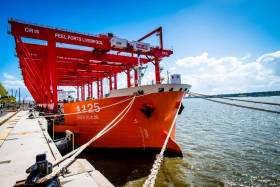Displaying items by tag: Giant Cranes for Liverpool2
#GiantCranes – Giant Chinese constructed cantilever rail-mounted gantry (CRMG) cranes arrived by heavylift vessel to Peel Ports Liverpool2 new £300m deep-water container terminal over the May Bank Holiday, writes Jehan Ashmore.
The CRMG cranes, the first of six are to be installed at Liverpool2, the Merseyside quayriver facility (not Liverpool Docks) to berth considerably larger and deep draft containerships. Docking at the port development was heavylift vessel, Zhenhua 25 that set off with the cranes from Nantong,China on the 11,930nm/20,000km voyage to Liverpool.
The 40 day passage of Zhenhua 25, took a route via south-east Asia, India, the Arabian Peninsula and through the Suez Canal before finally completing the voyage to Liverpool last Sunday.
On the opposite side of the Irish Sea, the Peel Port Group are the operators of the Dublin Port container terminal, Marine Terminal Ltd. At the MTL terminal near Ringsend, one of the largest vessels ships to use the facility, Nicholas Delmas (capacity: 2,207 TEU's) departed yesterday.
The Chinese built Nicholas Delmas had arrived from Liverpool from where the new quayside CRMG cranes to be installed having been also constructed by a Chinese manufacturer, ZPMC. According to the Peel Ports Liverpool, ZPMC also supplied the five ship-to-shore cranes already on site at the entrance to the port.
This first batch of CRMG's are the first of 12 required for phase 1 of the terminal. Ultimately the site will have eight STS and 22 CRMG cranes as part of a £100m investment.
The cranes will be capable of performing an average of 20 moves per hour, with semi-automated control linked to the port’s new Navis N4 terminal operating system. They have a 40 tonne under-spreader capacity and a maximum container lift height above quay level of 21m under spreader (6+1 containers).
Liverpool2 is to have a phased opening, with marine trials due to begin shortly and other elements of the semi-automated terminal coming online throughout Q2 of 2016. The first phase of the new terminal will be fully operational in the autumn.





























































